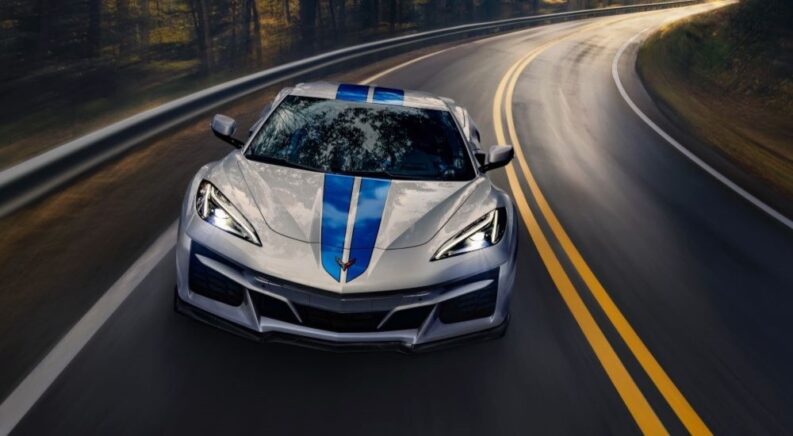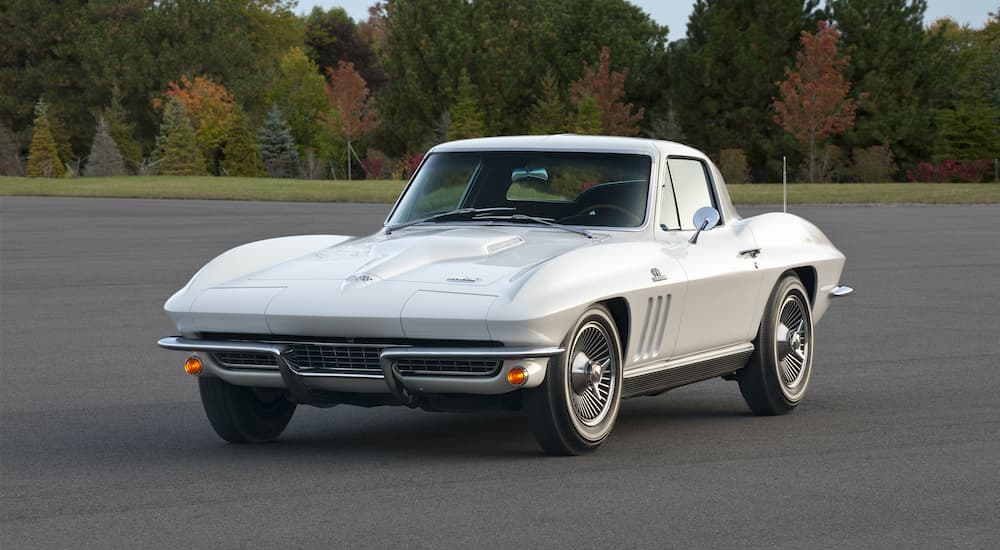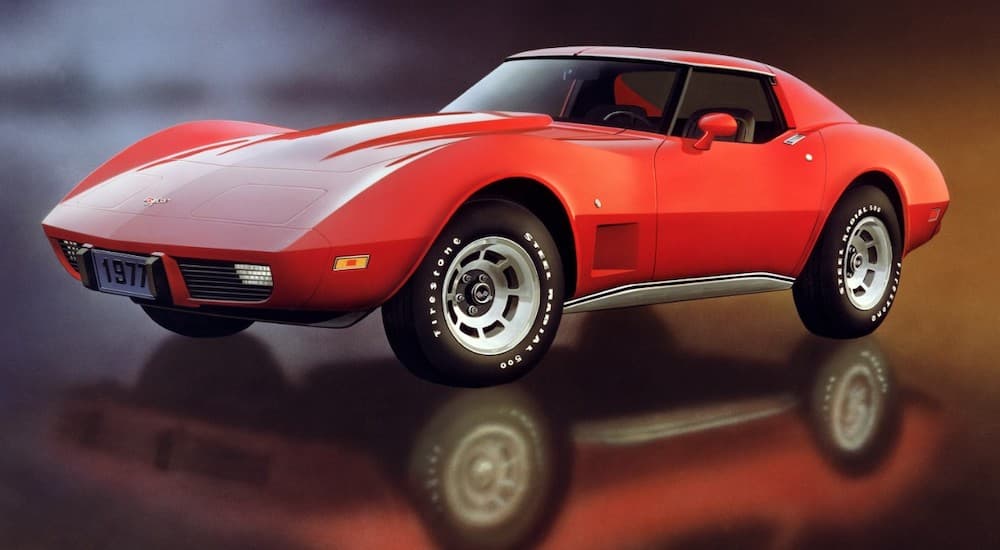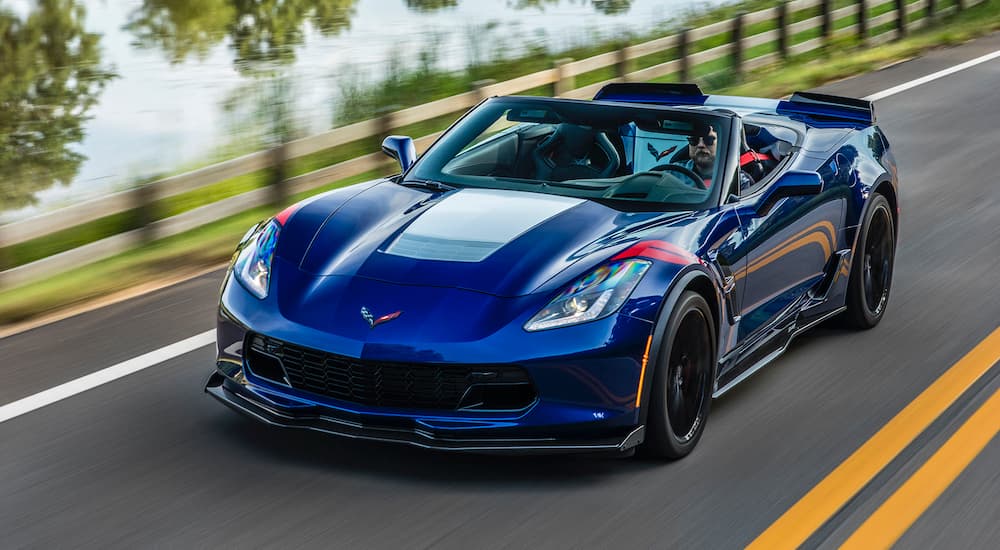Commonly referred to as “America’s Sports Car,” the Corvette ranks somewhere between baseball and apple pie in the eyes of V8-loving patriots. The Corvette isn’t just an American icon—it’s also the only two-seat sports car still produced in the good old U-S-of-A, delivering true American muscle to thrill-seeking drivers. Built exclusively in Bowling Green, Kentucky—also home to the National Corvette Museum—the Corvette has achieved legendary status thanks to a focus on engineering, style, and high-performance fun.
As the 2023 Corvette Stingray prepares to enter your local Chevy dealer, we thought it would be the perfect time to take a look at the history of this celebrated feat of American engineering—but first, a little housekeeping. Automotive naming conventions can often be confusing at the best of times (we’ll blame the marketing department) but the Corvette Stingray is an especially confusing case. Just to clear up a little confusion from the start: Sting Ray (or “Stingray,” depending on the generation) isn’t a specific model of Corvette, but rather an alternate name for the base model that’s been used off and on throughout the sports car’s 70-year run.
To put it in the form of a fun logic puzzle: every Stingray is a Corvette, but not every Corvette is a Stingray. The name was used for the sports car’s second and third generations and then revived in 2014 for the seventh and eighth generations. There are no specific equipment, features, or design choices that set a “Stingray” apart from a Corvette, but Chevy’s lack of commitment to the moniker has led to some confusion among drivers. We will focus largely on Stingray-branded Corvettes for this article, but that’s only because we have a soft spot for cars named after sleek aquatic predators. Read on and see how the Corvette Stingray grew from an underwhelming imitation of British sports cars into the indelible artifact of Americana we know it as today.
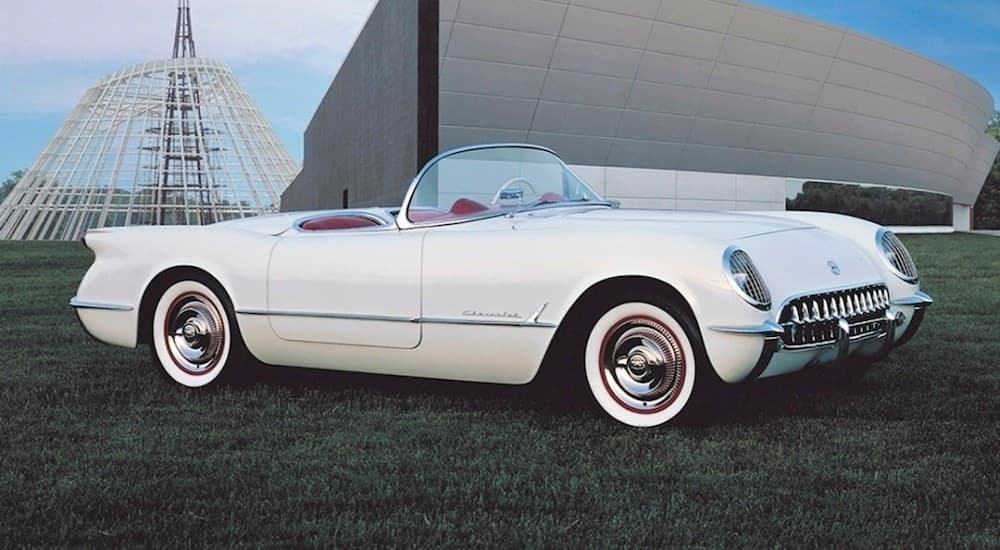
Testing the Waters
Before we delve into the history of the Stingray, we need to look a little further back at the genesis of the Corvette itself. We start in the 1950s, with Chevy’s sales faltering and the automaker looking to inject a little excitement into its lineup. The solution? A new sports car that put an American spin on the classic British designs that were so popular at the time. Nicknamed Project Opel, the concept version of the Corvette was notable for its light fiberglass body, 3.9L straight-six engine, and a novel two-speed automatic transmission. The first-generation Corvette—now known as the C1—debuted at GM’s 1953 Motorama auto show to considerable praise, leading Chevy to turn the concept vehicle into a limited production model for the 1953 model year.
The bowtie brand produced 300 units of the C1 Corvette, which was able to squeeze an impressive 150 hp out of Chevy’s Blue Flame inline-six thanks to an innovative new glass fiber-reinforced plastic chassis that significantly improved the sports car’s power-to-weight ratio. The fledgling ‘Vette also had a decidedly sporty appearance with a 55-degree raked windshield, Polo White paint job, and vibrant red interior, but the wider driving public was largely unimpressed. Chevy sold just 183 units of the C1 Corvette as drivers and critics panned for trying—and failing—to split the difference between a grand touring model and a true sports car.
With slow sales and an underwhelming ride, the Corvette might have been little more than a flash in the pan if not for the intervention of one Zora Arkus-Duntov. This Belgian-born engineer first saw the Corvette at the 1953 Motorama and, while he was won over by its bold styling, he found the model’s technical specs to be a little subpar. Arkus-Duntov had earned his stripes producing a line of overhead valve aluminum cylinder heads for Ford’s flathead V8 engine, solving its infamous overheating issue, adding horsepower, and drumming up considerable sales for his company, Ardun Mechanical Corporation (AMC). Far from being just a drafting table savant, Arkus-Duntov was also a respected auto racer in his own right, entering the 24 Hours of Le Mans endurance race from 1952 to ’55 and earning a class win behind the wheel of a Porsche 550 RS Spyder in 1955.
Arkus-Duntov saw the potential of the Corvette and knew he wanted to be involved in its development. The engineer landed a job at Chevy soon after the show and never stopped dreaming of ways to improve the Corvette. That process would begin when Arkus-Duntov authored an internal memo titled “Thoughts Pertaining to Youth, Hot Rodders, and Chevrolet,” which posited that a new V8 engine would allow the Corvette to achieve its full potential. Chevy brass took note and, in 1955, the automaker would finally grace the sports car with a 4.3L small-block V8 producing 195 hp. The upgrade allowed the Corvette to take its place among the true sports car elite, with the new engine shaving 1.5 seconds off the model’s zero-to-sixty time.
Chevy would continue to perfect the Corvette over the coming years, tweaking the sports car’s aesthetics to include new scalloped sides, a power-operated folding roof, dual headlamps, and more. Engineering was never an afterthought, and the automaker continued to up the model’s power throughout the first generation, from 290 hp after the introduction of fuel injection and up to 360 hp by 1962 thanks to a new 5.4L V8.
C2 (1963-1967)
The second-generation Corvette marked the introduction of the first “Sting Ray.” This model marked a significant evolution over the first-gen version, featuring a completely restyled front end, tapering rear deck, chassis, and a new independent rear suspension. Of course, the Sting Ray’s most notable feature was the one that would inspire the new aquatic name: a split rear window that gave the Corvette a stingray-like appearance when viewed from the top down.
The sports car started as the XP-87 concept vehicle produced by Arkus-Duntov and fellow Chevy engineer Bill Mitchell during the end of the C1 Corvette production run. It was largely a way for the duo to explore the sport’s car high-performance potential. One problem: a ban from the Automotive Manufacturers Association following a deadly crash barred brands from entering production vehicles in auto races. That wouldn’t stop Mitchell, who bought his own Corvette SS chassis and worked after-hours to produce the Mitchell Sting Ray in 1959. The nascent Sting Ray found success at the track, earning a class win upon its debut and an SCCA National Championship in 1960.
The rest of the Chevy engineering team took note of Mitchell’s success, creating the Q Corvette concept based largely on his Sting Ray design. The Q Corvette would morph into the XP-755 Mako Shark concept and, by 1963, enter full production as the Corvette Sting Ray. While the second-generation Corvette would become an instant classic thanks to its high-performance specs and unique style, one key feature wouldn’t last past the first model year: the split rear window—despite having inspired the vehicle’s name—was seen as a safety hazard by Arkus-Duntov, who successfully lobbied for its removal for the 1964 model year. The C2 Sting Ray would debut with 360 hp, but the introduction of a big-block V8 in 1965 would see that figure upped to 425 hp.
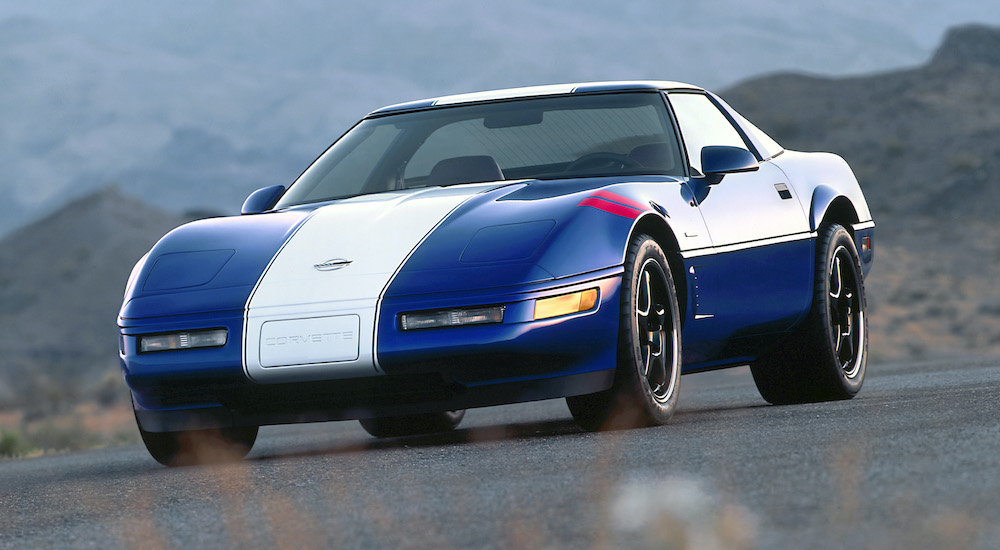
C3 (1968–1977)
By 1968, the Corvette was ready for a refresh. The previous five years had been good to Chevy, with the Sting Ray capturing the hearts and minds of the driving public. Eager to improve on its success, Chevy turned to the Mako Shark II concept to inform the design of the next-generation Corvette. Mechanically, the C3 was largely a holdover from the previous version at first. The third-generation Corvette “Stingray” (now one word) featured many of the same powertrains as its predecessor, although Chevy did switch the 5.3L engine with a 5.7L version, change the two-speed automatic transmission to a three-speed offering, and up the optional 7.0L big block V8 for a 7.4L version. Producing 425 hp, the big block V8-powered Corvette is widely considered to be the most powerful version of the classic sports car.
The major differences between the C2 and C3 come down to design. The third-generation Stingray is easy to spot thanks to its T-top removable roof panels, which allows drivers to transform the coupe into an open-air ride with minimal fuss. Chevy also deleted the rear storage area and—in 1969—further confused the world by compressing the “Sting Ray” name into the shorter “Stingray.”
This sports car would win some high-profile fans throughout its long production run, becoming the car of choice for America’s newly minted heroes, the Apollo astronauts. The Corvette would see a noticeable decrease in power as tightening environmental standards saw the introduction of components and fuels devised to reduce emissions. The Stingray name would disappear from the Corvette lineup in the 1977 model year and wouldn’t return until the seventh generation hit the market in 2014.
C7 (2014-2019)
After a long absence, the Stingray made its triumphant return in the new 2014 seventh-generation (C7) model. Built on a front engine and a rear-wheel drive platform, the C7 Corvette was designed to appeal to a younger driving audience than previous models. Chevy knew it needed to refresh the Corvette’s reputation after so many years on the market, and it took a youth-centric marketing approach to draw the attention of newer drivers. Case in point: a camo version of the classic sports car was included in the popular racing video game Gran Turismo 5, and the C7 Corvette was also used as the pace car at the 2013 Indianapolis 500.
The C7 represented a thoroughly modern take on the storied model. Powered by a 6.2L V8 putting out 455-460 hp, the LT1 engine included a full suite of advanced tech, including direct injection, active fuel management, and variable valve timing. Drivers could choose between a seven-speed manual or a six- or eight-speed automatic (depending on the year) which were paired with the polarizing paddle shifters.
In trying to appeal to a younger generation, Chevy knew the Corvette style would be paramount. To that end, the automaker gave the C7 Corvette a thorough makeover that included a new carbon fiber hood and removable roof panels, new seats, a revamped Corvette flag logo, and—most notably—a small stingray icon. Liberal use of carbon-nano composite material and a new aluminum frame meant a lighter, more powerful car—although maybe not quite as practical as it once was, with the Corvette’s luggage space shrinking by 33%. The highlight of the C7 era is generally agreed to be the Corvette Grand Sport (GS) model; built with a wide-body chassis styled after the high-performance Z06 model, the GS was powered by a smaller engine than the Z06—a combination that won over critics with its ideal blend of power and precision.
C8 (2020-present)
That brings us to the Stringray of today, the Corvette C8. As Chevy’s first-ever mid-engine sports car, it’s hard to mistake the C8 for any other generation of the venerable ‘Vette. The engine placement isn’t the only first for the C8, which also boasts the Corvette’s first retractable hardtop and is the first generation in the model’s history not to include a manual transmission. In some ways, it’s surprising that it took Chevy so long to experiment with the mid-engine design; placing a vehicle’s engine behind the cabin has long been the hallmark of high-performance sports cars as it allows for more even weight distribution, improving traction and responsiveness while aiding in accelerating, cornering, and braking. The Corvette’s mid-engine design was all the more impressive given its price: starting at less than $60,000, the C8 is a bonafide bargain in its segment.
The engine’s placement is a nice upgrade, but it’s the V8’s impressive power that makes the C8 Corvette so fun to drive. The 6.2L naturally-aspirated LT2 engine pumps out some 490 hp (or 495 with the optional performance exhaust package or Z51 performance package). Those numbers should be more than enough to satisfy the average driver, but if you’re looking to really plaster your head against the back of the driver’s seat, the C8 Z06 is just the ticket. While not a Stingray by definition, we’d be remiss if we didn’t take a moment to mention the high-performance model’s specs.
With a 5.5L V8 LT6 engine under the [trunk’s] hood, the Z06 has the distinction of being the most powerful naturally-aspirated engine on the market, with an output of 670 hp. We also look forward to getting behind the wheel of the upcoming C8 Corvette E-Ray which—while, again, not a true Stingray—marks an exciting evolution in the sports car’s long history as its first-ever hybrid model. The E-Ray will combine an electric motor with the LT2 V8, giving drivers the best of both worlds while allowing them to spend much less at the pump.
Inside, the C8 Corvette includes all the modern amenities with an interior that punches well above its MSRP with leather, suede, and real metal accents throughout. The cabin has a decidedly “cockpit” feel, with knobs, switches, and its display screens being all slightly angled towards the driver for maximum convenience and control. A squared-off steering wheel and 12.0-inch configurable digital gauge display will have drivers feeling like they’re behind the wheel of a true race car—as will the lack of storage space. The Corvette does feature two storage areas at the front and rear of the vehicle, but they only offer a combined 13 cu.ft. of stowage. But that’s a sacrifice we’re willing to make for a vehicle that’s so exciting to drive, and it’s far from a dealbreaker in the sporty segment.
Throughout its history, the Chevy Corvette has been dedicated to upping the bar for the American sports car. There have been many imitators over the years, but those in the know return to the Corvette time and time again when in pursuit of unrivaled performance, style, and panache. From the earliest, relatively underpowered V6 model to the rubber-burning C8 with 495 hp, the Corvette has come a long way over the years, integrating the latest-and-greatest in automotive technology to set a pace that few other automakers can match. There’s a reason the Corvette is often referred to as an American classic: as the only two-seat sports car still built on US soil, the Corvette is a true reflection of everything there is to love about the domestic auto market—raw power, bold style, and a curious fixation with animal names that we still can’t seem to shake after all these years.

